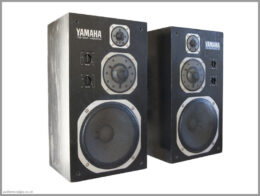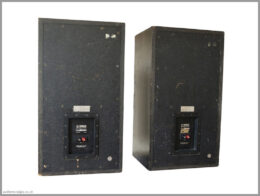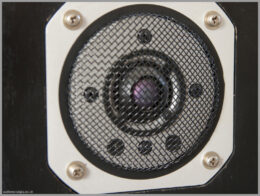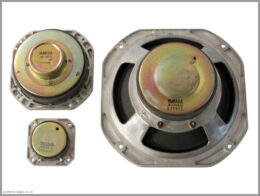TABLE OF CONTENTS
MY STORY
Yamaha NS-1000 M were not the speakers that I ever considered buying. I was aware of their legendary status and I like their look, but for some reasons, I was always more attracted to British speakers. This was not until I found a pair of NS-1000 M for a reasonable amount of money, near the place where I used to live. I ended up with light wallet and very, very heavy speakers.
Please note – usually before reviewing vintage speakers, I recap the crossovers to ensure that capacitors are within manufacturer’s specification. On this occasion, even though the capacitors were within the specs, because I was going to keep the speakers, I decided to recap, to see if audible improvements can be made. To start with, I have listened to the speakers as they were (original condition), and then replaced the original capacitors in the crossovers with modern film caps of the same values. Following my usual methodical approach, I only recapped one speaker and left the other one as it was. After this I concluded listening tests in mono and discovered that the recap made very little difference to the sound (borderline of perception). For the purpose of this review I left the speakers recapped with basic film capacitors, as to my ears, these did not alter the sound when compared with original crossovers. If I could turn back the time, I probably would not bother recapping, as the original capacitors are of a very good quality.
SPEAKER INFO
Model History
The Yamaha NS-1000 were designed and released to the market in 1974. They received very good reviews in British HiFi press in the late 70s. There were two versions of these speakers. The one referred to as “NS-1000” was designed with domestic market in mind and had enclosures made of solid wood, which gave each speaker an impressive weight of 39kg! The “NS-1000 Monitor” were designed with studio use in mind and featured the same components as the domestic version, but had the enclosures made of veneered chipboard with plywood bracing, giving them equally impressive weight of 31kg per speakers.
Design
Design of Yamaha NS-1000, even by today’s standards, is outstanding. And it is not only the already mentioned extremely well made cabinets, but also the drivers and components inside. Here we have a 3-way loudspeaker, housed in a sealed enclosure. The woofer has a 12in compressed paper pulp cone, and crosses over to the midrange driver at 500Hz. Midrange and tweeter feature exotic and extremely rigid beryllium domes, and they are crossed over at 6kHz. Nominal impedance is 8Ω and claimed sensitivity is 90dB, so these speakers should be relatively easy to drive.
YAMAHA NS-1000M SPECS
| Frequency Response: | 40 – 20,000Hz |
| Sensitivity: | 90dB (1W input, measured at 1m) |
| Impedance: | 8Ω |
| Power Capacity: | 100W (continuous program) |
| High Frequency Driver: | JA0513 30mm (1.2″) Beryllium Dome |
| Medium Frequency Driver: | JA0801 88mm (3.5″) Beryllium Dome |
| Low Frequency Driver: | JA3055A 300mm (12″) Paper Diaphragm |
| Crossover Frequencies: | 500Hz & 6,000Hz |
| Enclosure Type: | Closed |
| Enclosure Dimensions (HxWxD): | 675x375x326mm (26.5×14.75×12.75″) |
| Weight: | 31kg (each speaker) |
| Production Year: | 1974 |
| Price When Launched: | £340 for a pair |
| Equivalent Present Day Price: | £3,700 for a pair |
| Current UK Price: | £600 to £1,500 for a pair |
LOOK & FEEL OF YAMAHA NS-1000 SPEAKERS
Visually, I think these speakers look very attractive. Silver driver baskets contrasting with matt black enclosures look very much 80s, but I like that look a lot.
The enclosure walls are made of 25-30mm chipboard, veneered on both sides. Internal bracing is made of 30mm thick plywood. All the joints are supported with triangular pieces of solid wood. The circle waste created by cutting out the hole for the bass driver was re-used and glued to the back wall of the cabinet (good thinking!). All inner walls are covered with 1cm thick felt. The enclosures are filled with fibber glass damping material. Very impressive construction.
Another impressive thing about these speakers are the state of the art drivers. Usage of exotic materials such as beryllium for tweeter and midrange domes is one thing, but quality of how these drivers are made is another. The drivers look very neat, especially when you compare them with the British constructions from the same era. The thing that stands out the most is the size of the magnets on the midrange drivers – they are just huge!
Crossovers are very well made too, with decent capacitors that despite the age, managed to maintain the specified capacitance and respectable ESR values. The speakers are equipped with two attenuators (L-Pads), that allow control of treble and midrange levels. Many people see them these days as a bad thing to have. I personally like them, especially considering how well these are made.
Yamaha NS-1000 M are by far the best build vintage speakers that I have seen to date. Amazing!
SOUND OF YAMAHA NS-1000M
First Impressions
Gentleman who I bought the speakers from was confident that they will sound better than any other speakers that I have had at the time. I obviously took his words with a pinch of salt. At the time I was using Celestion Ditton 66 and was really pleased with their performance. Imagine my surprises when I plugged in the Yamahas and they sounded much cleaner than my Celestions… The difference was quite obvious and as a result, I decided to use Yamaha NS-1000 M as my main speakers for couple of months, to see what else they were capable of.
Bass
The bass from Yamaha NS-1000 is quite deep considering the enclosure size. It is not as deep as I would like it to be, however, when you live with them long enough, the feeling goes away on most recordings. On the other hand, once you’ve heard songs with deep bass reproduced on a full range system, you will always expect to hear that – and that is not always going to be possible with the NS-1000. The bass is ‘quick’ as you would expect from a sealed enclosure, however, this is probably the weakest area of the NS1000. The resolution in bass just does not seem to be that high. When I played recording of drums on NS1000M and compared it side by side with JBL L100, the drums on the JBLs sounded much more realistic. That is not to say that bass of the NS-1000 is bad. You can still get a lot of enjoyment from these speakers, but the bass quality is just not their strenght.
Midrange, Treble, and Soundstage
The quality and clarity of treble and midrange is astonishing, even by modern standards. Vocals sound very realistic and transparent. There is plenty of air around the instruments, which is especially noticeable on live recordings and gives a great sense of having artists performing in your living room. I would not necessary say that the sound stage is particularly deep, but despite this, Yamaha NS-1000 are still very engaging. If I was to criticise anything about the treble and midrange, I would say that sometimes they sound too analytical, and therefore, cold. Or perhaps there is just too much of energy in that area. There are some recordings that just sound better on other speakers, such as previously mentioned Celestion Ditton 66. A good example of that is In My Father’s House by Eric Bibb which just sounds a lot more enjoyable on the Celestions, and not very engaging on Yamahas.
Because of this trait combined with limited low end extension, Yamaha NS-1000 M can sometimes sound bright. I would also say that they are not the best for quiet listening. It feels to me that to get most of them, you need play them at realistic listening levels. It’s worth noting that NS-1000 M can be played at very high levels without sounding distorted or loosing resolution and clarity of sound – very impressive and reminds me of equally impressive composure of Tannoy Little Gold Monitor speakers. With demining tracks such as Race With Devil On Turkish Highway by Al Di Meola there are no audible signs of compression, even when played very loud.
CONCLUSION
Yamaha NS-1000 M are superb speakers with top notch build quality and very impressive resolution. When it comes to midrange and treble, these are one of most transparent speakers I have heard to date. Bass is not as impressive though – it lacks details and extension. These are very analytical, so not for people who like gentle and sweet sound.
| Balance of Sound: | |
| Neutrality of Tone: | |
| Transparency: | |
| Soundstage: | |
| Attack: | |
| Engagement: | |
| Total Score: |
SONGS MENTIONED IN THIS REVIEW
Al Di Meola – Race With Devil On Turkish Highway
Eric Bibb – In My Father’s House
Reviewed: April 2015 | Published: May 2015











